
The Yuan Wang-class of tracking ships are used for tracking and support of satellite and intercontinental ballistic missiles by the People's Liberation Army Strategic Support Force of the People's Republic of China (PRC). This class is not a single design, but instead is a group of different designs under the same series that share the same name.
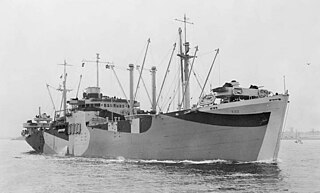
Type C1 was a designation for cargo ships built for the United States Maritime Commission before and during World War II. Total production was 493 ships built from 1940 to 1945. The first C1 types were the smallest of the three original Maritime Commission designs, meant for shorter routes where high speed and capacity were less important. Only a handful were delivered prior to Pearl Harbor. But many C1-A and C1-B ships were already in the works and were delivered during 1942. Many were converted to military purposes including troop transports during the war.

USNS Observation Island (T-AGM-23) was built as the Mariner-class merchant ship Empire State Mariner for the United States Maritime Commission, launched 15 August 1953, and operated by United States Lines upon delivery on 24 February 1954, making voyages for the Military Sea Transportation Service (MSTS) until going into reserve at Mobile, Alabama on 9 November 1954.
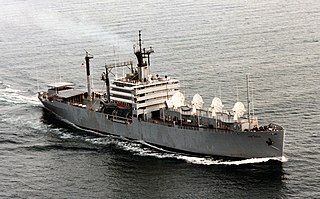
A tracking ship, also called a missile range instrumentation ship or range ship, is a ship equipped with antennas and electronics to support the launching and tracking of missiles and rockets. Since many missile ranges launch over ocean areas for safety reasons, range ships are used to extend the range of shore-based tracking facilities.

USAS American Mariner was a United States Army research vessel from January 1959 to 30 September 1963. She was originally assigned to the DAMP Project by the Advanced Research Projects Agency (ARPA) to attempt to collect radar signature data on incoming intercontinental ballistic missiles in the Caribbean, the South Atlantic Ocean, and the Indian Ocean. Her initial operations involved providing radar track on the Atlas missile, which was under development at the time. Subsequently, she provided track on other types of missiles as they proceeded through their development and operational stages. In September 1963 the original contract was transferred to the USAF until the completion of the testing phase in 1964.
The Missile Test Project (MTP) was a U.S. Air Force program operated by RCA Service Company (RCAS) from Patrick Air Force Base, Florida, under the direction of prime contractor Pan American Guided Missiles Research Division during the 1950s and continuing on for several more decades. Under this program, RCAS instrumented and operated various ships and stations on the Air Force Eastern Test Range with electronic tracking and telemetry equipment. The instrumented ships and stations tracked incoming intercontinental ballistic missiles launched from Cape Canaveral Air Force Station (CCAFS) and, using radar or telemetry, also tracked crewed or uncrewed space vehicles orbiting the Earth.

USNS General Hoyt S. Vandenberg (T-AGM-10) was a General G. O. Squier-class transport ship in the United States Navy in World War II named in honor of U.S. Army Chief of Engineers Harry Taylor. She served for a time as army transport USAT General Harry Taylor, and was reacquired by the navy in 1950 as USNS General Harry Taylor (T-AP-145).

The General G. O. Squier class of transport ships was built for the U.S. Navy during World War II. The class was based upon the Maritime Commission's Type C4 ship. The class was named for United States Army Major General George Owen Squier.

USNS General H. H. Arnold (T-AGM-9) was a General G. O. Squier-class transport ship for the U.S. Navy in World War II. She was named in honor of U.S. Army general Robert Emmet Callan. She was transferred to the U.S. Army as USAT General R. E. Callan in 1946. On 28 April 1950 she was transferred to the Military Sea Transportation Service (MSTS) as USNS General R. E. Callan (T-AP-139). Placed in reserve in 1958, she was transferred to the U.S. Air Force in 1961 and renamed USAFS General H. H. Arnold in 1963, in honor of Henry H. Arnold, the first and only General of the Air Force. She was reacquired by the Navy in 1964 as USNS General H. H. Arnold (T-AGM-9). She was struck from the Naval Vessel Register on 1 March 1982.

The Type C4-class ship were the largest cargo ships built by the United States Maritime Commission (MARCOM) during World War II. The design was originally developed for the American-Hawaiian Lines in 1941, but in late 1941 the plans were taken over by the MARCOM.

USNS Range Recoverer (T-AG-161/T-AGM-2/YFRT-524) was a missile range instrumentation ship responsible for providing radar and/or telemetry track data on missiles launched from American launch sites.

SS Haiti Victory (T-AGM-238) was originally built and operated as Greenville class cargo Victory ship which operated as a cargo carrier in both the Atlantic Ocean and the Pacific Ocean during World War II.

USNS Private Joe E. Mann (T-AK-253) was a Boulder Victory-class cargo ship acquired in 1950, from the U.S. Army, where she was known as the USAT Private Joe E. Mann.

SS Dalton Victory was built as Victory ship used as a cargo ship for World War II under the Emergency Shipbuilding program. She was launched by the California Shipbuilding Company on 6 June 1944 and completed on 19 July 1944 as a Greenville Victory-class cargo ship. The ship’s United States Maritime Commission designation was VC2- S- AP3, hull number 21. She was acquired by the U.S. Navy in 1950 and renamed the USNS Dalton Victory (T-AK-256).
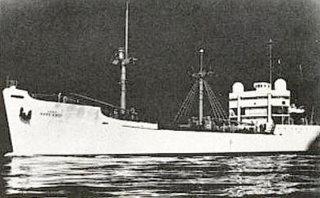
USNS Rose Knot (T-AGM-14) was a World War II era United States Maritime Commission small cargo ship built in 1945 and delivered to the War Shipping Administration for operation through agent shipping companies and for periods by the Military Sea Transportation Service (MSTS). In 1957 the ship was transferred to the Air Force and converted into a missile range instrumentation ship which operated as USAFS Rose Knot on the U.S. Air Force's Eastern Test Range during the late 1950s and early 1960s. Rose Knot operated under an Air Force contract with Pan American Airways Guided Missile Range Division headquartered in Cocoa Beach, Florida. In July 1964, all Air Force tracking ships were transferred to MSTS for operation with the Air Force in operational control while the ships were at sea as tracking ships. Rose Knot had special facilities for supporting the human spaceflight program and supported the early crewed flights. The ship was owned by the U.S. government until sold for non-transportation use in 1977.
USS Somerset (AK-212) was an Alamosa-class cargo ship that was constructed for the US Navy during the closing period of World War II. She was later acquired by the US Army in 1946 and the US Air Force in 1957 before being reacquired by the USN as the USNS Coastal Sentry (T-AGM-15), a missile range instrumentation ship.

USNS Coastal Crusader (AK-220/ORV-16/T-AGM-16/AGS-36) was an Alamosa-class cargo ship that was constructed for the US Navy during the closing period of World War II. She was later acquired by the US Army in 1946 and the US Air Force in 1957 before being reacquired by the USN in 1964 and as a missile range instrumentation ship.
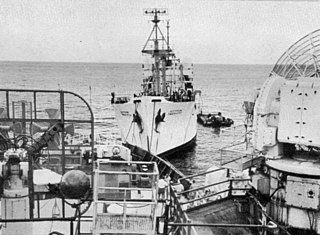
USNS Timber Hitch (T-AGM-17) was a US Navy missile range instrumentation ship which earlier operated as the US Air Force Ocean Range VesselUSAFS Timber Hitch (ORV-17) on the US Air Force's Eastern Test Range during the late 1950s and early 1960s. Timber Hitch operated under an Air Force contract with Pan American Airways Guided Missile Range Division headquartered in Cocoa Beach, Florida.
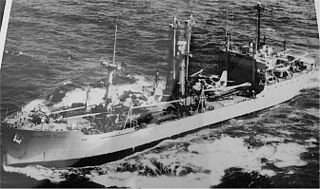
USNS Colonel William J. O’Brien (T-AK-246) was a US Maritime Administration (MARCOM) C1-M-AV1 type coastal cargo ship, originally planned as an Alamosa-class cargo ship. Constructed as Maiden's Eye for the MARCOM, completed in August 1945 and placed in operation by the War Shipping Administration (WSA). After the war Maiden's Eye was transferred to the US Army and renamed USAT Colonel William J. O’Brien who kept her in service until transferred to the US Navy in 1950 for operation as USNS Colonel William J. O’Brien (T-AK-246) by the Military Sea Transportation Service (MSTS) until 1973.



















